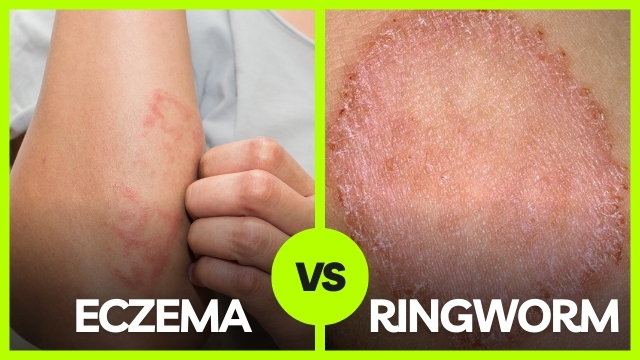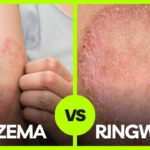Allergic reactions can manifest in various forms, often confusing individuals due to similar symptoms. Distinguishing between ringworm and eczema is crucial for effective treatment and management. This article explores the differences, symptoms, causes, diagnosis, and treatment options for these common skin conditions.
Introduction
Allergic reactions can cause distress and discomfort, particularly when conditions like ringworm and eczema present similar symptoms. Understanding these conditions’ distinct characteristics is essential for accurate diagnosis and treatment.
What is Ringworm?
Despite its name, Ringworm is not caused by worms but by fungi known as dermatophytes. It manifests as a circular, red rash with clear skin in the center, resembling a ring. There are several types of ringworm infections, including athlete’s foot (tinea pedis) and jock itch (tinea cruris). Symptoms typically include itching, redness, and scaling of the skin.
Causes of Ringworm
Ringworm spreads through direct contact with an infected person or animal or by touching contaminated surfaces like towels, clothing, or gym equipment. Fungal spores thrive in warm, moist environments, making certain conditions like shared locker rooms or close skin-to-skin contact common sources of infection.
Diagnosis of Ringworm
Healthcare providers diagnose ringworm by examining the affected area and possibly taking a skin scraping for microscopic analysis. Wood’s lamp examination or fungal culture may also confirm the diagnosis.
Treatment Options for Ringworm
Treatment for ringworm typically involves antifungal medications, either applied topically or taken orally, depending on the severity and location of the infection. Over-the-counter antifungal creams like clotrimazole or prescription medications may be prescribed.
What is Eczema?
Eczema, or atopic dermatitis, is a chronic inflammatory skin condition characterized by dry, itchy skin and recurring flare-ups. It can affect people of all ages and often runs in families. Eczema appears as red, inflamed skin patches that may blister, ooze, or crust over.
Causes of Eczema
The exact cause of eczema has yet to be fully understood. Still, it is believed to involve a combination of genetic factors, abnormal immune responses, and environmental triggers such as allergens, stress, or irritants like soaps and detergents.
Diagnosis of Eczema
Diagnosing eczema involves a thorough clinical examination by a dermatologist or healthcare provider. They may also consider a patient’s medical history and may perform tests to rule out other skin conditions or allergies that could mimic eczema.
Treatment Options for Eczema
Managing eczema focuses on relieving symptoms and preventing flare-ups. Treatment may include moisturizing creams, topical corticosteroids to reduce inflammation, and antihistamines to alleviate itching. Lifestyle changes such as avoiding triggers and maintaining proper skincare routines are also essential.
Differences Between Ringworm and Eczema
Differentiating between ringworm and eczema is crucial due to their distinct causes, symptoms, and treatments. Ringworm presents as a circular rash with raised edges and central clearing, while eczema appears as red, inflamed patches that may be dry, scaly, or weeping.
Prevention Strategies
Preventing allergic reactions involves practicing good hygiene, avoiding sharing personal items, and maintaining a clean environment. For ringworm, keeping skin dry and wearing clean, breathable clothing can reduce the risk of infection. Eczema prevention focuses on identifying and avoiding triggers such as allergens or irritants.
Managing Allergic Reactions
Early identification and prompt treatment of allergic reactions like ringworm and eczema are essential to prevent complications and improve quality of life. Consulting a healthcare professional for proper diagnosis and individualized treatment is recommended.
Case Studies and Real-Life Examples
Patient stories and experiences can provide insight into living with allergic skin conditions like ringworm and eczema, showcasing different treatment approaches and challenges.
Conclusion
Distinguishing between ringworm and eczema is critical for effective management and treatment. Individuals can better navigate allergic reactions and achieve healthier skin by understanding their causes, symptoms, and treatment options.
FAQs
What are the main symptoms of ringworm?
Ringworm typically presents as a circular, red rash with clear skin in the center, often accompanied by itching and scaling.
How is eczema different from ringworm?
Eczema appears as red, inflamed patches of skin that may be dry, scaly, or weeping, whereas a fungal infection causes ringworm and presents as a circular rash.
Can ringworm be spread from person to person?
Yes, ringworms can spread through contact with an infected person, animal, or contaminated surfaces.
What are common triggers for eczema flare-ups?
Common triggers include allergens like pollen or pet dander, irritants like harsh soaps or detergents, stress, and changes in temperature or humidity.
How can I prevent allergic reactions like ringworm and eczema?
Preventive measures include practicing good hygiene, avoiding sharing personal items, identifying and avoiding triggers, and maintaining a healthy skincare routine.




